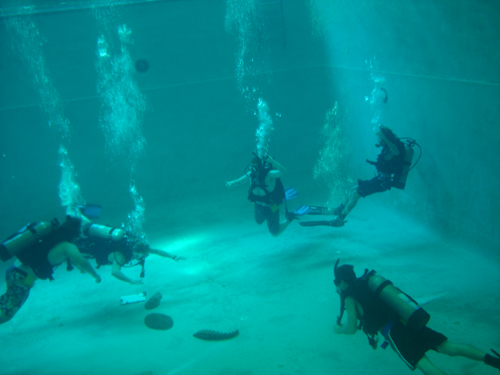One of our more exciting projects here at LAMP is our high school underwater archaeology program, which when it began in 2000 became the first such program in the U.S. that we know of. LAMP assists teacher Ken Jones with this class, which is available as an elective to students at Pedro Menendez High School. This year’s class, the first to be taught under LAMP’s new leadership, has undergone significant structural changes. One such change is an increased emphasis on basic diving training. For the first time LAMP staff will be teaching and certifying the students themselves, and this scuba training has been expanded to run the entire school semester, culminating with a series of five open water dives. By putting young people in the water with archaeologists, and introducing them to the underwater world, we really do feel that we change lives.
The students participate in one of two two-hour pool sessions each week, taught after school by LAMP Director and NAUI diving instructor Chuck Meide at Sea Hunt Scuba Shop.

As the weekly pool sessions progress, the students are taught the basic skills necessary to become safe, relaxed, and confident scuba divers. They are drilled over and over again in these practical skills, until they become almost second nature. By the semester’s end, they will have undergone many more hours of in-water training than most typical dive shop scuba classes.
A good foundation of dive training is necessary for archaeological divers who wish to safely and efficiently gather data from underwater sites. Here Chuck supervises Menendez High students David Jackson and Mark McCrimion as they practice buddy breathing. This skill involves one diver sharing his air supply with a second out-of-air diver, passing the regulator back and forth. The students will master this skill, and practice it while stationary on the bottom, while swimming and ascending to the surface, and without wearing masks.
Meanwhile, Chuck also visits their classroom at Menendez High once a week, for a discussion of diving physics, physiology, safe diving practices, and similar topics. On other class days, LAMP Director of Archaeology Sam Turner, and FPAN Northeast Regional Center Director Sarah Miller visit the students for lectures and hands-on activities related to maritime and terrestrial archaeology.

Towards the end of the semester, the students undergo a series of open water checkout dives. To ensure a diverse diving experience for the student, they will dive in both freshwater springs and saltwater ocean environments. During these dives, the students will demonstrate their mastery of the basic skills they have learned in the pool in order to earn their certification.
The first two dives took place in early December at Ginnie Springs, near the towns of Fort White and High Springs in central Florida. Here one group of students is about to submerge, under the supervision of instructor Chuck Meide and volunteer divemaster John Carpenter.
Meanwhile, the next group of students prepares to enter the water, once the first group has surfaced. In order to maximize safety, the student divers are divided into groups of no more than 4 to 5 individuals. Each group will make two dives with LAMP instructional staff.
It takes a lot of effort to organize 15 dive students for six dives while managing all of the equipment needed to make this happen. LAMP’s regular staff are aided by a host of volunteer surface support team members–here are Jeff, Adam, Trevor, Dave, Ken (Menendez High teacher), and John. I have no idea what Dave was doing with that wacky pool noodle as I was underwater all day long.
Under their instructor’s supervision, each student performs a series of skills. These include regulator recovery . . .
. . . buddy breathing . . .
. . . and out-of-air emergency ascents.
Towards the end of their first dive, the students are lead on a tour of Ginnie Spring.
On their second dive, the students take a tour of three other springs feeding the Santa Fe River, starting with a dynamic fissure in the limestone known as Little Devil.
After descending to a depth of around 30 feet, the students return to the mouth of the chasm and then make their way down the spring run toward the next spring, Devil’s Eye. The Eye is a round pit on the river-bottom limestone.
The final spring is Devil’s Ear. This is a particularly dynamic spring, characterized by fallen logs lodged in the limestone crags, and a very powerful current flowing from the cave entrance at a depth of about 40 feet.
Student diver David Pouliotte pauses for a moment on a suspended tree branch before continuing his descent.
LAMP volunteer David Huber accompanies the dive groups on their second dive. He took most of the underwater photos you’ve seen here.
By day’s end, LAMP’s instructor and divemaster had been in the water for over six hours straight in order to conduct six checkout dives. Students, staff, and volunteers all had a great time, but probably those most excited at completing the dives were our students. Ginnie Springs, with its spectacular limestone topography, is one of the most beautiful dive freshwater dive sites in the nation. The crystal-clear visibility here is a far cry from our wreck sites offshore St. Augustine. That will be our next stop, and the final checkout dives are planned for the first weekend of January. There the students will have a chance to put their training to work as they will complete their first dives on a historic shipwrecks. Stay tuned!

